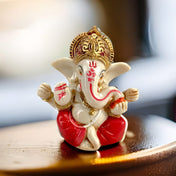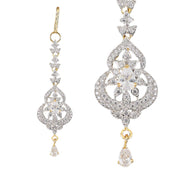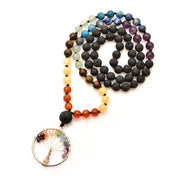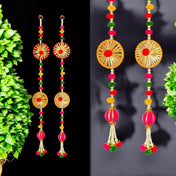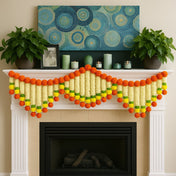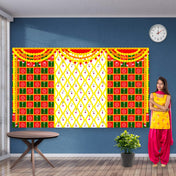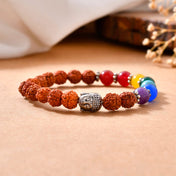Introduction
Indian torans are colorful and beautifully crafted decorations that have a special place in home decor. These decorative hangings, usually hung at doorways, serve both as attractive decor and cultural symbols. They represent more than just decoration; they symbolize warmth, protection, and hospitality, welcoming guests and creating a positive atmosphere in the home.
The history of torans dates back to ancient Indian traditions. They originated from Vedic customs and have since become important elements that beautify any space. The colors, designs, and materials used in these pieces showcase regional artistry and tell cultural stories.

At LoveNspire, our mission is to promote cultural heritage through carefully selected products. We offer a wide range of items that celebrate traditional craftsmanship, with the goal of bridging cultural gaps and bringing joy through unique gifts. Each toran has its own story, connecting modern lifestyles with ancient traditions. By adding these beautiful pieces to your home decor, you not only enhance your living space but also embrace meaningful connections rooted in culture and history.
What is a Traditional Indian Toran?
A toran is a decorative hanging that adorns the entrance of homes, symbolizing welcome and positivity. Rooted in Vedic traditions, torans have been an integral part of Indian households for centuries. Historically, these adornments were crafted using natural materials like flowers, leaves, and cloth, intertwining beauty with purpose.

The cultural symbolism associated with torans is profound:
- Warmth: Torans are believed to create a hospitable environment, inviting guests into a home filled with joy.
- Protection: Traditionally, they are thought to ward off negative energies and bring good fortune to residents.
In various cultures across India, torans feature prominently in ceremonies, festivals, and daily life. Their vibrant colors and intricate designs reflect the rich tapestry of Indian heritage. Each toran tells a story—one of familial bonds, auspicious beginnings, and cultural continuity.
As we explore the significance of torans further in this article, their role in enhancing home decor becomes even more evident. Embracing these traditions not only beautifies spaces but also fosters a deep connection to cultural roots. For instance, 5 feet marigold jasmine door toran hanging valances are popular choices for festivals and weddings. Similarly, Mango Leaf Marigold garland/Toran collections add a touch of tradition to homes. Furthermore, a 42 inches Ganesha Indian door toran can serve as an ethnic hanging valance for indoor or outdoor decor.

The Cultural Significance of Torans in Indian Homes
Indian torans are more than just decorative pieces; they represent good luck, hospitality, and wealth. These colorful decorations are usually hung at the entrance of homes, creating a warm and welcoming atmosphere for guests. Their presence signifies a genuine welcome, reflecting the importance of hospitality in Indian culture.
1. Welcoming Guests
Hanging a toran at doorways symbolizes an open invitation to friends and family. It fosters a sense of belonging and creates an environment where relationships can flourish.
2. Festivals and Celebrations
Torans play an important role during various festivals such as Diwali, where they are used to decorate homes with joy and vibrancy. Their bright designs add to the festive spirit, marking significant occasions that bring families and communities together.
The cultural significance of torans goes beyond their visual appeal. They capture the essence of Indian traditions, serving as channels for positive energy and goodwill. By adorning homes with these handcrafted treasures, one not only enhances decor but also honors the rich heritage they represent.
Festivals and Occasions for Using Torans
Torans hold a special place in Indian culture, particularly during significant festivals and ceremonies.
1. Diwali Celebrations
Known as the festival of lights, Diwali is a time when homes are adorned with decorations symbolizing joy and prosperity. Torans, often embellished with vibrant colors and intricate designs, are hung at entrances to invite positivity and good fortune. A popular choice for this occasion is the marigold jasmine door toran, which adds a festive touch to the décor. Their presence signifies the triumph of light over darkness, making them an essential part of Diwali celebrations.
2. Griha Pravesh Ceremonies
This ritual marks the auspicious occasion of moving into a new home. Torans play a vital role in these ceremonies, representing warmth and protection. Traditionally crafted from natural materials, they are believed to ward off negative energies, ensuring a harmonious environment for the newly settled family. The decorative aspect of torans enhances the celebratory spirit of Griha Pravesh, creating an inviting atmosphere for family and friends. For instance, a 5 feet marigold mango leaf door toran could be used to embellish the entrance, welcoming guests with its vibrant hues.
By embracing these cultural traditions through torans, one can enrich personal spaces with meaning while celebrating cherished customs. Whether it's using a 5 feet marigold jasmine door toran for Diwali or a mango leaf one for Griha Pravesh, these decorative pieces serve as more than just adornments; they are symbols of cultural heritage and familial warmth.
Evolution of Toran Designs
The evolution of toran designs reflects a beautiful blend of tradition and modernity. Initially, traditional torans were crafted from natural materials such as flowers, leaves, and fabric. These elements not only added a touch of nature to home decor but also held cultural significance, representing the cycle of life and renewal.
For example, the marigold jasmine door toran, often used during festivals like Diwali, is a perfect illustration of this traditional approach.
With time, contemporary adaptations emerged, incorporating a variety of materials like metal, wood, and even acrylic. This shift allowed for more innovative designs that cater to diverse aesthetic preferences while maintaining the essence of their traditional roots. The Toran collection available today showcases this evolution beautifully.
Regional styles play a crucial role in the diversity of toran designs. For instance:
- Rajasthani torans often feature vibrant colors and mirror work.
- Maharashtrian torans may showcase intricate beadwork and motifs inspired by local festivals.
Each region's unique cultural identity contributes to an array of styles, making decorating with torans an exciting exploration of Indian heritage. The integration of modern techniques and materials has opened new avenues for creativity, allowing torans to fit seamlessly into various interior design schemes while honoring their rich history.
For instance, the multicolor bead door toran represents the Maharashtrian style with its intricate beadwork. Such pieces not only serve as decorative items but also add a traditional touch to your home decor as suggested in this guide on decorating with torans.
Popular Variations of Torans
Torans come in a vibrant array of styles, each reflecting unique cultural narratives and regional artistry. Among the most cherished variations are:
1. Ganesh Torans
Adorned with motifs of Lord Ganesh, these torans symbolize prosperity and the removal of obstacles. Often crafted using colorful fabric or beads, they are particularly popular during festive seasons, serving as auspicious decorations at entrances.
2. Rajasthani Torans
Known for their intricate embroidery and mirror work, Rajasthani torans showcase the rich heritage of Rajasthan. These pieces often feature traditional patterns and bold colors, making them striking focal points in any home decor.
3. Bhandawal Torans
This lesser-known style features delicate embellishments made from natural materials like flowers and leaves. Bhandawal torans embody a connection to nature, bringing a refreshing touch to modern interiors.
The use of colors plays a significant role in each region's designs. Bright hues like red, yellow, and green dominate traditional styles, while contemporary adaptations may incorporate muted tones or metallic accents to suit modern aesthetics. Materials range from textiles to wood and metal, showcasing the skillful craftsmanship behind each piece.
Each variation not only enhances the beauty of a space but also carries deep cultural significance, inviting warmth and positivity into homes.
Incorporating Torans into Modern Home Decor
Integrating traditional Indian torans into contemporary interior design can create a unique atmosphere that celebrates cultural heritage while enhancing modern aesthetics. Here are some practical tips to achieve this harmonious blend:
1. Decorative Accents
Position torans at entrances or on windowsills to serve as inviting focal points. Their vibrant colors and intricate designs immediately draw attention and set a welcoming tone.
2. Layering Textures
Combine torans with other decorative elements like wooden frames or glass vases. This layering technique adds depth and visual interest, allowing the toran to shine as a statement piece.
3. Color Coordination
Choose torans that complement the existing color palette of your space. For instance, a bright, Ganesh-themed toran can enliven a neutral-toned room, infusing it with warmth.
4. Mixing Styles
Pair traditional torans with modern furniture pieces. A minimalist sofa accented by a richly detailed toran can create an engaging contrast that celebrates both styles.
5. Seasonal Displays
Rotate torans based on seasonal themes or festivals. This not only refreshes your decor but also keeps the cultural significance alive within your home.
Incorporating these elements allows for an inviting space where traditional beauty meets modern elegance, making every moment spent at home feel special.
Styling Tips for Your Home with Torans
Creating an inviting atmosphere in your home can be accomplished through thoughtful styling of torans, catering to various decor preferences. Here are some practical tips:
1. Minimalist Decor
Embrace a serene aesthetic by selecting neutral-toned torans. Soft beiges, whites, and grays complement a minimalist theme while adding subtle texture. Hang them at entrances or over windows to enhance natural light without overwhelming the space.
2. Eclectic Styles
For those who love bold expressions, opt for vibrant, patterned torans that reflect cultural artistry. Rich colors and intricate designs can serve as statement pieces in eclectic interiors. Consider layering multiple torans or pairing them with decorative elements like wall art and cushions to create a dynamic focal point.
3. Balancing Elements
Integrate torans with other decor items that share similar hues or themes. This approach fosters harmony while allowing the unique characteristics of the toran to shine through.
Incorporating these styling strategies will ensure that your home remains both culturally enriched and aesthetically pleasing, making every corner a celebration of heritage and modernity.
DIY Options for Personalized Torans
Creating your own handmade decor can be a delightful way to express creativity in home decor. Personalized torans not only add character to your space but also reflect your unique style. Here’s how you can craft beautiful torans at home.
Materials Needed
- Fabrics: Cotton, silk, or jute in vibrant colors
- Thread and Needle: For stitching and embellishing
- Beads, Sequins, or Mirrors: To add decorative elements
- Scissors: For cutting fabric and threads
- Decorative String or Rope: For hanging the toran
- Glue (optional): For securing embellishments
Steps to Create Your Toran
- Select Your Fabric: Choose a fabric that resonates with your home’s color palette.
- Cut the Fabric: Cut the fabric into the desired shape, typically rectangular or triangular.
- Embellish: Sew or glue beads, sequins, or mirrors onto the fabric, creating patterns that appeal to you.
- Attach the Hanging String: Securely attach the decorative string or rope at the top for easy hanging.
- Display Creatively: Hang your personalized toran at entrances, windows, or even as part of a wall arrangement.
Crafting your own toran fosters a stronger connection to cultural heritage while allowing for personal expression. Each piece becomes a heartfelt addition to your home decor.
Supporting Local Artisans through the Use of Torans & LoveNspire's Commitment to Cultural Heritage
Supporting local artisans is vital for preserving traditional crafts and skills that have been passed down through generations. By purchasing artisan craftsmanship products, such as Indian torans, individuals contribute to the sustainability of unique cultural expressions. These handcrafted items not only reflect the rich heritage of India but also ensure that skilled artisans continue to thrive.
LoveNspire stands at the forefront of this movement, providing a platform for artisans to showcase their work. The brand’s commitment to cultural preservation is evident in its carefully curated ethnic products collection. Each piece tells a story, bridging the gap between tradition and contemporary life. This philosophy resonates deeply with customers who seek to enrich their homes with meaningful decor that honors cultural roots.
LoveNspire’s Offerings
- Traditional Crafts: LoveNspire offers an array of products that celebrate Indian craftsmanship, including beautifully designed torans that embody both aesthetic appeal and cultural significance.
- Diverse Selections: With over 2000 unique items ranging from home décor to gifting essentials, each product is a testament to the artistry of local artisans.
- Cultural Expression: The brand emphasizes the importance of sharing diverse cultural narratives through its collections, promoting understanding and appreciation among different communities.
By choosing to incorporate traditional Indian torans into home decor, customers not only enhance their living spaces but also support a broader mission—one that values craftsmanship while fostering connections across cultures. Each purchase becomes part of a larger tapestry that celebrates diversity and highlights the importance of preserving these timeless traditions.
In doing so, LoveNspire invites everyone to engage with cultural heritage in a modern context, ensuring that these artisan skills endure for future generations.
Conclusion
Embracing culture at home can be a transformative experience. Incorporating Traditional Indian Torans into your decor not only enhances the aesthetic appeal of your space but also infuses it with positive energy and warmth.
Consider these benefits:
- Symbolism: Torans symbolize protection and welcome, making them perfect for any entryway.
- Cultural Connection: Each toran tells a story, bridging the gap between tradition and modernity.
- Versatility: They can complement various decor styles, from minimalist to eclectic.
By choosing torans, you celebrate Indian craftsmanship while creating meaningful connections within your home. LoveNspire offers exquisite options that honor these traditions, inviting you to explore the beauty of cultural heritage. Embrace the richness of Indian decor and let the vibrant essence of torans transform your living space into a sanctuary of joy and positivity.










